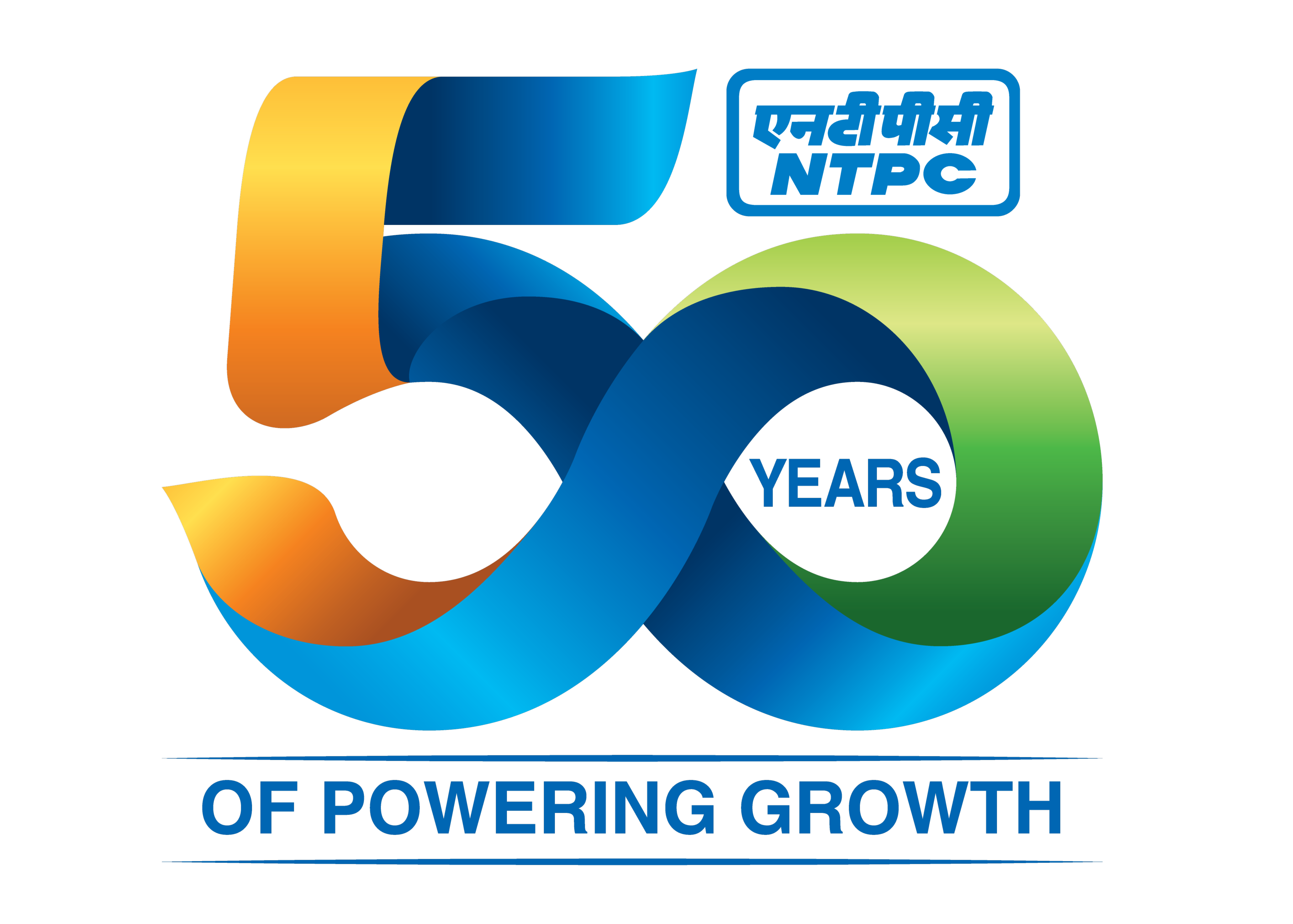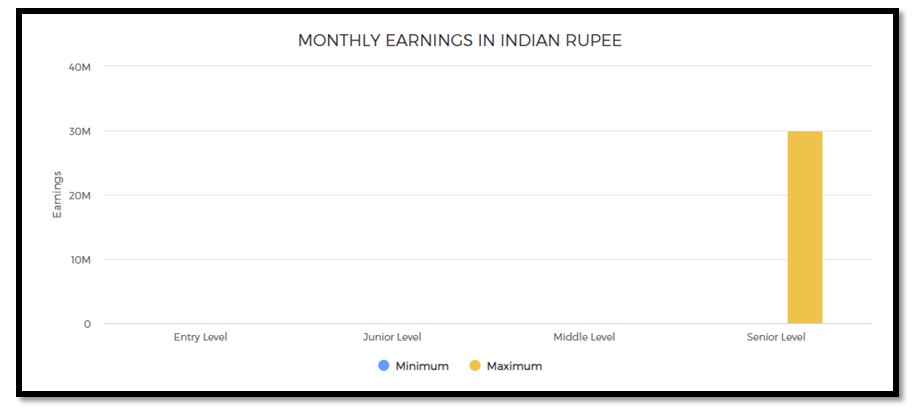Athlete
Entry Level Qualification
8
Career Fields
Sports & Fitness
For Specially Abled



Career Entrance Exam
About Career
PARTICULARS | DESCRIPTION |
Name | Athlete |
Purpose | maintaining optimum physical fitness |
Career Field | Sports & Fitness |
Required Entrance Exam | No Entrance Exam |
Average Salary | 150000 - 300000 Rs. Per Year |
Companies For You | The Athlete Academy, LevelPlay Sports Inc & Many More |
Who is Eligible | Any One |
1. As a professional Athlete/Sportsperson, you will be engaged in playing a particular kind of sport and participating in state, national or international sporting or athletic competitions/events. The popularity of a sport creates the maximum impact on the number of opportunities available to make a living from competing.
2. You will be competing in trials and competitions at various levels, from amateur, semi-professional to professional. However, you will also need a great deal of talent for maintaining a full-time career since only a few make it to the pinnacle of glory in this field.
3. You will have to attend trainings on a regular basis including early mornings, evenings and weekends, or 'off-season’ irrespective of weather conditions. You will be receiving regular advice from coaches, trainers, physical therapists and dieticians to ensure maximum sporting performance.
4. You will be expected to follow a strict diet particularly tailored for your kind of sport. You may have to take part in promotional activities and media interviews. You may also be involved in providing guidance on techniques and training to young aspirants.
5. Most begin focused training from a very young age. The length of your career in competitive sports will primarily depend on your age, degree of fitness and level of achievement. Frequent travel is usually involved as you may have to be at different locations, interstate or overseas, to compete.
Key Roles And Responsibilities:
As a professional Athlete/Sportsperson, you will be engaged with one or more of the following roles and responsibilities: -
1. You will be attending scheduled training or practice sessions and will be exercising or practising under the direction of athletic trainers or professional coaches for developing your skills, improving your physical metrics and preparing for competitions.
2. You will be maintaining optimum physical fitness levels by training regularly, consulting with health professionals and following nutrition plans.
3. You will be participating in athletic or competitive sporting events, according to established rules and regulations.
4. You will be representing professional sports clubs or teams and performing activities such as meeting with the media, delivering speeches, or participating in social events.
5. You will be identifying your strengths and weaknesses while playing or training and work towards improving them.
6. You will have to understand the mentality of each of your teammates to foster better team ideals, develop a dynamic system of interrelationships, enhance performance metrics and achieve incredible results.
7. You will be involved in conducting research and studies and interacting in discussions with fellow playmates to enhance both your professional and technical knowledge about the sport.
Career Entry Pathway
(For Cricket) Class 5 in school – continue training – play for domestic cricket teams – selection to international squad
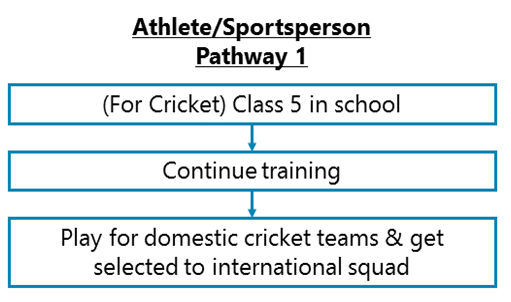
It is preferable to start training as early as possible and continue your primary school level education simultaneously. Start playing at the domestic level for first-class competitions, limited over cricket and twenty 20 competitions and in state-wise U-15 (under 15 years), U-17 (under 17 years) and U-19 teams (under 19 years). Domestic tournaments include 1. first-class competitions like the Ranji Trophy, Duleep Trophy, Irani Trophy (the first match of this championship is played between the Ranji Trophy champion and Rest of India); 2. Limited over cricket tournaments like Deodhar Trophy (among the 3 national level teams - India A, B, C teams), Vijay Hazare Trophy (This tournament commits the states’ teams from Ranji trophy battling in 50 over format. It is also known as the Premium cup by BCCI), BCCI Corporate Trophy; 3. Twenty-20 competitions like Syed Mushtaq Ali Trophy, Indian Premium League (IPL), Interstate T-20 championship (replaced by IPL), Women's T20 Challenger Trophy, Women's T20 League, Women's T20 Challenge. For Ranji Trophy, all the states of India represent their teams. Some states have more than one team e.g. Maharashtra and Gujarat. There is also a team for Railways and Services (armed forces). Teams are further divided into zones- East, West, North, and South. Selection to the international squad and the national cricket team of India is through these domestic levels as well as the selection tournaments organized by BCCI.
(For Football) Class 5 in school – continue football training – Baby Leagues (4 to 12 years of age) – Youth Leagues (U-13, U-15, U-18) - national final round – absorption into senior national Football team
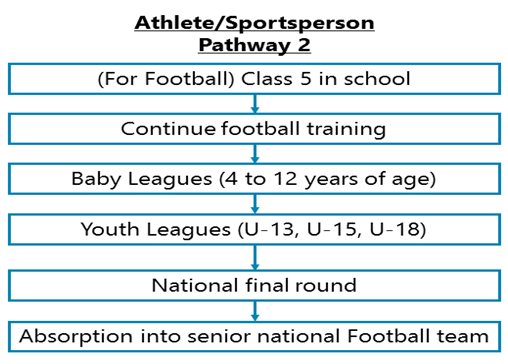
You shall start training as early as 4 years of age and participate in Baby Leagues organized at a local level in each district. These allow participants till 12 years of age. You will have to continue school level education simultaneously while training and competing. There is a free mobile application that was launched by AIFF which can be used to register and participate in ongoing competitions nearby. Then you have to participate in the U13, U15 and U18 Youth Leagues to be identified and inducted to the Indian Arrows team for playing in the I-League. These players are expected to form the core of the U19 and U23 national teams as well as the senior national team in future. Indian Women's League (IWL) in projected to cover 25 states by 2022. In addition to association football, Futsal is also being patronized through different tournament formats including AIFF FUTSAL CUP, U-13, U-15, U-18 competitions. It is mandatory for all the 3404 clubs across the country to develop Futsal teams now.
(All Sports) Class 5 in school – continue training in your discipline – participate in junior level competitions – participate in National University Games – participate in World University Championships – represent India in national squad
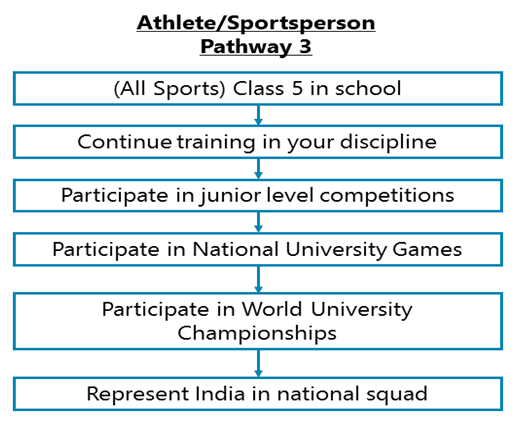
While in Class 5, you can continue training in your discipline and also participate in junior stage competitions at the local or district levels. Then you can take part in National University Games including Vizzy Trophy Cricket Tournament and Champion Universities Hockey Tournament. Then you can participate in World University Championships held abroad every year as part of Indian universities teams. Sports Authority of India (SAI) under Ministry of Youth Affairs & Sports, Government of India is the apex body conducting training of athletes and improving the sports facilities. SAI Coaches appointed in different coaching centers under different disciplines are categorized under different schemes to train the trainees like National Sports Talent Contest Scheme (NSTC-stay, play and study for 8-12 year olds), Army Boys Sports Companies (ABSC-in collaboration with the Army), SAI Training Centres Scheme (STC: for 14-21 year olds who have secured positions at District, State and National Competitions), Special Area Games Scheme (SAG-from tribal, rural, coastal and hilly areas of the country), Centre of Excellence and Sports Academics. Coaches and trainers at SAI are considerably involved in the selection of players at the international level. Khelo India - National Programme for Development of Sports Scheme helps a user to search an exhaustive database for sporting facilities across the nation through the Khelo India app. The database includes SAI facilities, SAI-supported facilities, and private facilities. Come and Play Scheme has opened designated areas in SAI stadiums for community sports. National Playing Fields Association of India (NPFAI) is encouraging Indian children to play sports by building more playing fields and spaces in the country.
(Sports Entry into Defence Forces) Class 10 all subjects as per scheme of studies – Class 11-12 Physics, Chemistry, and Mathematics along with any other subject as per scheme of studies – participate in sporting events – join Defense Forces
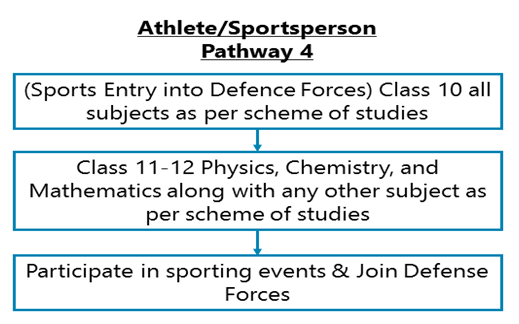
After completing Class 11-12 Physics, Chemistry, and Mathematics along with any other subject as per scheme of studies, you can join Tri-services (Defense Forces/Armed Forces) directly through a selection process if you are established as a sportsperson and have represented the country in Junior/Senior sports meets. The disciplines are restricted to (a) Athletics (b) Basketball (c) Boxing (d) Cricket (e) Diving (f) Golf (g) Gymnastics (h) Hockey (j) Kabaddi (k) Lawn Tennis (l) Squash (m) Swimming (n) Volleyball (o) Water Polo (p) Weight Lifting (q) Wrestling (r) Wushu. You must have attained the minimum standard of 5th place in the Junior National Championship, represented the State/Units in Senior National Championships or Inter University Championship in above mentioned sports discipline. In team events, the individual should have represented state in Junior National Championship and National School Tournaments conducted by School Games Federation of India (SGFI). The latest achievements would be given preference during the selection trials. It will be better if you have already represented the Services team at least twice in three years in National championship events.
Required Qualification & Competencies
1. There is no mandate of any formal educational qualification for being a Sportsperson or Athlete. You can start training as early as 4 years of age. The most essential factor in determining your success in future is your performance in amateur competitive sports events or later in various levels of professional competitive sports events.
2. In order to get selected for scientific research based training in national-level institutes of repute you will have to create a portfolio of certificates to exhibit all the sports events that you have participated in. You will also have to appear for trial, physical tests, and medical tests.
3. These institutes look for aspirants aged between 8 and 25 and depending on your age your portfolio will be evaluated.
4. Some eminent Sportspersons like Mahesh Bhupati, Pullela Gopichand, Mary Kom, Bhaichung Bhutia, Gagan Narang and Prakash Padukone have their own training institutes too where young players are selected only on merit and facilities are provided on a scholarship basis.
Minimum education required | Maximum education required |
Under Secondary Certificate Programs For Which The Minimum Eligibility Is A Pass In Any Class Below Class X. | Post-Secondary Certificate / Diploma Programs For Which The Minimum Eligibility Is A Pass In Class X. |
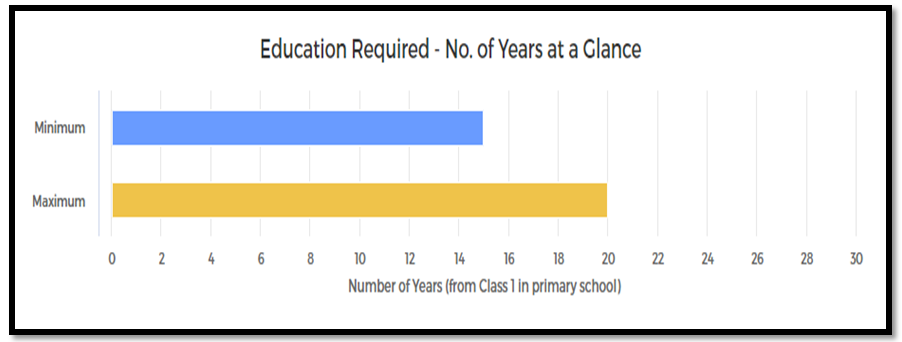
Competencies Required
1. You should have interests for Realistic Occupations. Realistic occupations involve more practical and hands-on activities than paperwork or office work. Realistic occupations often involve physical activities for getting things done using various tools and equipment.
2. You should have interests for Enterprising Occupations. Enterprising occupations involve taking initiatives, initiating actions, and planning to achieve goals, often business goals. These involve gathering resources and leading people to get things done. These require decision making, risk taking and action orientation.
3. You should have knowledge of Sports - Specialized knowledge about the various techniques, use of sports gears and rules and regulations about playing a sport or game.
4. You should have Active Listening Skills - Giving full attention to what other people are saying, understanding the points being made by others, asking questions, etc.
5. You should have Active Learning Skills - Focused and continuous learning from various sources of information, observation and otherwise for application in getting work done.
6. You should have Time Management Skills - Skills in prioritizing work, managing time effectively.
7. You should have Physical Stamina - The ability to exert yourself physically over long periods of time without getting winded or out of breath.
8. You should have Arm-Hand Steadiness - The ability to keep your hand and arm steady while moving your arm or while holding your arm and hand in one position.
9. You should have Bodily-Kinesthetic Intelligence - The ability to coordinate the movement of your arms, legs, and bodily motion; the ability to keep or regain your body balance when in an unstable position; the ability to quickly and repeatedly bend, stretch, twist, or reach out with your body, hands, arms, fingers, or legs.
10. You should have IntrapersonalAbility - The ability to clearly understand your strengths and weaknesses, what your capabilities are, what you can do and cannot do, what you like and dislike.
11. You should have Oral Comprehension Ability- listen to and understand information and ideas presented through spoken words and sentences.
12. You should have Deductive Reasoning Ability- apply general rules and common logic to specific problems to produce answers that are logical and make sense. For example, understanding the reasons behind an event or a situation using general rules and common logic.
13. You should have Inductive Reasoning Ability - The ability to combine pieces of information from various sources, concepts, and theories to form general rules or conclusions. For example, Analysing various events or situations to come out with a set of rules or conclusions.
14. You are always or mostly organized in your day-to-day life and activities.
15. You are always or mostly careful about your actions and behavior.
16. You are always or mostly disciplined in your action and behaviour.
17. You act independently sometimes but do not do so in some other times.
18. You prefer to experience new things and have new experiences sometimes.
Career - Job Opportunities & Profiles
1. As a professional Athlete/Sportsperson, you will be earning your living through participating in various competitive sporting or athletic events as part of professional sports clubs or teams as an individual Sportsperson or in a team.
2. The popularity of your sport is a major determining factor for the number of opportunities that you may find and for how long.
3. In most sports, players are generally selected into the national squad after they have delivered numerous national, state and district level performances. In cricket, there are U-19, U-17 and U-15 teams apart from the Senior Squad. Besides IPL, there are junior level tournaments like U-19 World Cup, Asia Cup.
4. In India, badminton is the 2nd most played sport after cricket. There are a number of sporting events in this space in addition to the Premier Badminton League (PBL). Notable teams of PBL include Awadhi Warriors, Hyderabad Hunters, Mumbai Rockets, Bengaluru Raptors, Pune 7 Aces.
5. The Badminton Association of India has an annual calendar that displays all major events both national and international like Dutch Open, French Open, Belgian Junior, Hyderabad Open, All India Sub Junior Ranking etc.
6. The biggest domestic league today among all non-cricketing properties is the Pro Kabaddi League with 61% viewership share closely followed by Kabaddi World Cup 2016, Indian Super League, Premier Badminton League, Kabaddi Masters (held in Dubai in 2018), Olympic Games and Hockey India League.
7. Top players auctioned into PKL teams like Puneri Paltan, UP Yoddha, Tamil Thalaivas have attracted the highest bids of more than Rs. 90 lakhs for the 7th edition of PKL. The auction was concluded in April 2019. Sports Media Giant ESPN considers Tamil Thalaivas to be in best shape for the imminent 7th edition of PKL. The Kabaddi World Cup held in 2019 was won by India with Iran being the runner-up. Kabaddi is most popular in Andhra Pradesh, Telangana, Maharashtra, Goa and Karnataka.
8. Indian Super League (ISL) is gaining popularity and is already very popular in football crazy markets like West Bengal, Kerala and Assam/North East/Sikkim. Atletico de Kolkata is the biggest team is terms of both squad size and market value followed by Kerala Blasters, Bengaluru FC, FC Goa, Mumbai City and Delhi Dynamos.
9. All India Football Federation is the highest governing body related to this sport in India. Apart from ISL, there is State League football (Calcutta Football League CFL-oldest in Asia) and Cup competitions. There are about 8500 directly registered players of IFA (Indian Football Association, Calcutta) who participate in CFL. Cup competitions include Federation Cup, Durand Cup, Super Cup, IFA Shield, Santosh Trophy. Moreover, women's national competition is played on a state vs. state basis in the India women's football championship.
10. AIFF has more than 60000 registered players, 38 clubs and 16 states registered in national professional leagues. India has also been the host nation for the 17th FIFA U-17 World Cup with record-breaking stadium attendance.
11. Baby Leagues are conducted by AIFF for kids aged between 4-12 years and then high potential young players are systematically absorbed into the senior national team through national, district, state youth leagues, Indian Arrows, 2nd Division Leagues, I-leagues/ISL.
12. There are 2 national field hockey teams in India to participate in various international events like Champions Trophy, Olympics and World Cup. In addition to these, there are state events and national tournaments.
13. The Indian Hockey Federation conducted the Premier Hockey League (PHL) for 4 years since 2005. The first edition was won by Hyderabad Sultans, then Bangalore Lions, next was won by Orissa Steelers and the last in 2008 was won by Bangalore Hi-fliers. Now it has been replaced by Hockey India League from 2013. The first winners were Ranchi Rhinos.
14. The All India Tennis Association has a tournament schedule that is extremely crowded with back to back competitions as Tennis is a popular game played worldwide. Events like Talent Series Tournaments, Championship Series Tournaments, World Junior Tennis Competitions, Development Championship by Asian Tennis Federation etc.
15. Besides, the number of opportunities varies geographically as it depends on regional popularity of a particular sport hence coaching and training opportunities also differ among the Indian states. Some sports like Thang-ta, Kalaripayattu, Silambam, Mukna, Mallakhamba, Khomlainai, Wushu may be popular in specific communities too but professional opportunities are limited.
Specialisation Tracks In This Career
1. Sportsperson (Athletics / Track and field)
This includes ‘Track and field’ class of sports (involving skills of running, jumping, and throwing) like competitive Sprinting/Running, Hurdle, Pole Vault, Shot Put, Discus, Javelin, Triathlon, Decathlon, Heptathlon, Long/High Jump etc.
2. Sportsperson (Boxing)
Boxing is a combat sport involving 2 people throwing punches at each other in a ring wearing protective gloves and helmet.
3. Sportsperson (Wrestling, Weightlifting)
Wrestling and Weightlifting are both based on sheer muscle power. Wrestling is a combat sport but Weightlifting falls under the class of ‘Strength Sports’.
4. Sportsperson (Shooting)
In Shooting the goal is to strike targets as accurately and possible with a gunshot.
5. Sportsperson (Swimming, Diving)
Swimming and Diving are aquatic sports. It can be played as a team sport or even individually. Both require one’s entire body to move through water.
6. Sportsperson (Volleyball, Basketball, Handball)
Volleyball, Basketball and Handball require players to play in a team and pocket a ball inside a net or hit a ball across a net wall using their hands primarily.
7. Sportsperson (Cycling, Biking, Mountain Biking)
Cycling, Biking and Mountain Biking involve riding bicycles or unicycles on defined course tracks, hilly areas and off-road terrain.
8. Sportsperson (Equestrian, polo)
Equestrian sports are played on horseback. Polo is also such a team sport. It is also one of the oldest known forms of team sport.
9. Sportsperson (Archery)
Archery exhibits a player’s skill of using a bow to shoot arrows accurately towards a target. It is also a technique globally known to be used by humans for thousands of years for combat and hunting.
10. Sportsperson (Badminton, Tennis, Table Tennis, Fencing)
Badminton, Tennis, Table Tennis and Fencing all involve extreme physical agility and require players to constantly change positions to either hit a ball / shuttlecock over a net wall or use a sword to fight the opponent as in Fencing. Badminton had originated in India.
11. Sportsperson (Field Hockey)
Field Hockey is played on grass, artificial turf, water turf or synthetic field with 11 players a side including a goalie.
12. Sportsperson (Football)
Football or Soccer specifically (Football may also mean American Football which is Rugby) is also played with 11 players a side including a goalie.
13. Sportsperson (Cricket)
Cricket is one of the most popular sports across the globe and undoubtedly the most popular in India. It is a bat-and-ball game played on a field between 2 teams with 11 players each.
14. Sportsperson (Kabaddi, Kho Kho)
Kabaddi is Indian in origin and is a team sport. It is a contact sport played between 2 teams with 7 players each. Kho is an ancient sport that originated in India as well and is played between 2 teams with 15 players each out of which 9 kneel on the field and try to avoid being touched by the opponent.
15. Sportsperson (Rugby union or Rugby)
Rugby originated in England and is a very popular sport across the world today. The game involves 2 teams of 15 players each who huddle across the field holding a ball in hand trying to reach the net.
16. Sportsperson (Chess)
Chess is a strategy based board game and is played individually. It may or may not be classified as a sport as by definition a sport has to involve competitors who are evaluated based on athletic activity and physical prowess both of which are not required in Chess but it does involve intense cerebral participation at both ends.
17. Sportsperson (Golf)
Golf is a club-and-ball sport which unlike most kinds of sports does not involve a defined playing area. Players use clubs to hit balls across the field to ‘put’ in a series of holes.
18. Sportsperson (Judo, Karate, Taekwondo)
Judo, Karate and Taekwondo are all types of combat and contact sports that were originally forms of martial arts used in military training. These later developed into Olympic sports.
19. Sportsperson (Motorsports - Formula Biking, BMX and Formula Car Racing)
In Motorsports drivers race to overtake each other’s motorized vehicles (bikes or cars). These races may be on defined cemented course tracks, hills or any off road terrain.
20. Sportsperson (Rowing, Surfing, Kayaking, Sailing)
Rowing, Surfing, Kayaking and Sailing are aquatic sports. Rowing can be dated back to the Egyptian civilization. Surfing is a surface water sport in which a surfer rides on the face of a moving wave to reach the shore whereas kayaks are low canoe-like boats.
Career Growth
1. You will remain an active Athlete/Sportsperson till your age, health and fitness levels permit.
2. After your retirement, you might set up your own training institutes or invest in any development relating to nurturing young talent in the field of sports or maybe for research in the spaces of sports sciences and sports medicine.
3. You could also become a commentator to assist in delivering expert comments during live broadcast.
4. You may take up coaching and training to become a professional coach to train young aspirants.
5. You can also publish your own novel or book to share your experiences and achievements if you are interested in the written word! If you do not wish to write yourself, you can always hire a professional writer for penning down your biography.
6. You could become a social influencer like a blogger or YouTuber and hire professionals to work on the content you wish to publish online through social sites. This is an extremely profitable business today. You can even try this before retirement.
Salary Offered
1. Earnings for Sportspeople can vary considerably based on their level of experience, the popularity of their sport, and the demand for new talent. As a Sportsperson develops skills, experience and reputation, their earning potential generally increases.
2. Income is not regularized as most Sportspeople earn through competing in events that are conducted across a year and subject to their performances they may or may not be retained by the national governing body concerned with a particular sport.
3. In most sports, players are generally selected into the national squad after they have delivered numerous national, state and district level performances.
4. Annual retainer ship fees (amount paid in advance to an individual to secure their services) paid by national sports control boards and governing bodies are still the highest for senior cricket players in India. Annual retainers are paid only to senior national team atheletes.
5. Additionally, endorsements and promotional activities pay extra and heftily if you can become a celebrated player. Virat Kohli’s the only Indian and only cricketer among the richest athletes in the world(Forbes) and his reported income through salaries/winnings is 27.5 crores whereas through endorsements it is 143 crores(18 brands among other investments).
Kabaddi
Kabaddi is the biggest emerging sport in the country. This year top players auctioned into Pro Kabaddi League (PKL) teams like Puneri Paltan, UP Yoddha, Tamil Thalaivas have attracted the highest bids of more than Rs. 90 lakhs for the 7th edition of PKL. Siddharth Desai fetched the biggest bid of Rs. 1.45 crores in April 2019 for the upcoming edition of PKL.
Raider Monu Goyat with a Rs. 1.51 PKL contract is the highest paid kabaddi player ever. The Indian national team participating in events like Kabaddi Masters has collective annual professional PKL contracts worth Rs. 9.21 crores.
Hockey
Since hockey players have no contracts with the Hockey India federation (HIF), they do not get salaries but match remunerations. The best hockey players of India receive around Rs. 15, 00, 000 a year as annual retainer. If the team manages to reach into the top six teams of the world, the retainership fee will be significantly hiked as promised by HIF. In addition, players are also likely to get Rs. 25000 per match.
Badminton
For badminton as sanctioned by Badminton Association of India, the total corpus for Senior Nationals / Senior Ranking Tournaments is Rs. 5 00 000, for Junior Nationals / Junior Ranking Tournaments it is Rs. 3 00 000, for Sub – Junior Nationals / Sub – Junior Ranking Tournaments it is Rs. 3 00 000 and for Doubles Ranking Tournaments it is Rs. 2 00 000. These prizes will be divided according to set ratios among winners, runner-ups, semi-finalists and quarter-finalists. These amounts can be increased by the organizers, but not reduced.
Cricket
1. In cricket, there are U-19, U-17 and U-15 teams apart from the Senior Squad. It continues to be the highest paying sport in the country with IPL (Indian Premier League) reaching to be a USD 6.3 billion franchise. The top 10 salaries in IPL 2019 (12th edition) ranged between INR 19 crores to 13 crores with Virat Kohli acing the list.
2. In cricket (as enumerated by BCCI), the per day fees for Senior players (above 23 years) is Rs. 12500-Rs. 35, 000 for the squad of 11 and for the reserves it is Rs. 6250-Rs. 17, 500. For U-23, it is Rs. 5500- Rs. 17, 500 (squad) and Rs. 2750-Rs. 8750 (reserves). For U-19, it is Rs. 5500-Rs. 10500 (squad) and Rs. 2750- Rs. 5250 (reserves). For U-16, it is Rs 5500-Rs. 3500 (squad) and Rs. 2750- Rs. 1750 (reserves). T20 match fees are 50% of the respective categories. Recently, BCCI decided to award INR 12,000 per match for every player, in addition to the match winning money.
3. The best cricket players of India (Grade A+) get an annual amount of Rs. 7, 00, 00,000 as retainer fees. That for Grade A is Rs 5 00 00 000, Grade B is Rs 3 00 00 000 and Grade C is Rs 1 00 00 000. These are applicable to the senior men’s national team only. For senior women’s team, there are no Grade A+ players. However, Grade A get Rs. 50 00 000, Grade B gets Rs. 30 00 000 and Grade C gets Rs. 10 00 000 as annual retainer respectively.
4. Champions of Ranji Trophy are awarded INR 2 crores which has to be split among all players. Runners up are awarded INR 1 crore and the third position teams are awarded INR 50 lakhs.
5. Currently, the match fee for a Ranji Trophy player is Rs 10,000 per day and he gets Rs. 40000 as match fee. However, a state team regularly earns around Rs 12 lakhs a season as the players get a percentage of broadcast rights earnings given at the end of the season as a lump sum amount.
6. Domestic cricketers are expected make Rs 20 00 000 a season up front from BCCI and another Rs 6 to 7 lakhs from BCCI’s gross revenue. Initially they were paid Rs 10 000 a day and currently they are making around Rs 35 000 a day.
7. The Committee of Administrators (CoA) for BCCI has fixed a total annual corpus of Rs. 125 crores for the Players Revenue / Compensation Equalization Fund. The remuneration of Team India (Senior Men) and other players is variable subject to the number of home matches played.
Football
Indian football players in the national squad earn a salary of more than Rs. 50 lakh a year. For players who play for clubs, the remuneration varies from player to player and club to club. For an example, Mahesh Gawli signed a Rs. 1 crore deal with Dempo Sports Club. Indian football players in the national squad earn Rs. 50 lakh a year as retainer fee.
Wrestling
India’s Yogeshwar Dutt earned 1.65 Lakhs/minute in Pro Wrestling League, which is India’s highest average salary/minute, even more than cricketers M. S. Dhoni and Virat Kohli.
In addition to this, some senior players receive honorary salaries too after they are awarded a rank in the military by the territorial army like as received by both Lt. Col. M S Dhoni and Lt. Col. Abhinav Bindra. They may wear the rank insignia as worn by other officers of the same rank and will receive both pay and pension according to the rank which is quite a substantial amount.
Monthly Earnings In Indian Rupee
Entry Level | Junior Level | Mid-Level | Senior Level | ||||
Min Earning | Max Earning | Min Earning | Max Earning | Min Earning | Max Earning | Min Earning | Max Earning |
2000 | 10000 | 5000 | 30000 | 10000 | 200000 | 15000 | 30000000 |
1. Entry level: 0 - 2 years of work experience
2. Junior Level: From 1 to 12 years of work experience
3. Mid-Level: From 5 to 20+ years of work experience
4. Senior Level: From 10 to 25+ years of work experience (there could be exceptions in some high-end technical, financial, engineering, creative, management, sports, and other careers; also in the near future, people will reach these levels much faster in many careers and in some careers, these levels will have no meaning as those careers will be completely tech skill driven such as even now, there is almost no level in a Cyber Security Expert’s job)
Work Activities
1. Playing a sport or game - Playing individual or team sports or games outdoor or indoor.
2. Performing physical activities - Performing physical activities that require use of your arms and legs and moving your whole body, such as climbing, lifting, balancing, walking, stooping, and handling of materials.
3. Exercising physically - Exercising physically using various methods, techniques, equipment and devices; exercising using a fitness regime; running.
4. Getting Information and learning - Observing, hearing, reading, using computers, or otherwise obtaining information and learning from it.
5. Developing and maintaining inter-personal relationships - Developing professional relationships with co-workers and others outside organisations and maintaining good relationships.
6. Communicating with co-workers and others– Communicating with people in writing, verbally or otherwise inside your workplace and various other people who have professional relationships with your place of work.
7. Working in a team - Working in a team of people; developing team; maintaining professional relationships among team members.
Future Prospects
1. You can expect a bright future in this field as the industry growth prospects are encouraging. The Indian Sports industry is estimated to touch the mark of 10 billion US Dollars . It is one of the fastest growing industries globally, the rate being 15% in India whereas 5% outside. For sports infrastructure development, the government has undertaken initiatives like a grant scheme with funding worth INR 942.5 million for infrastructure creation and setting up of synthetic turfs and surfaces worth INR 201.3 million have been undertaken.
2. Also, INR 328 million has been allocated for the promotion of sports at the grass-roots level and in colleges and universities. A special purpose vehicle (SPV) will also be formed for the construction of a world-class multi-sport residential Smart Sport City near Coimbatore. Modern forms of PPP like Refurbish, Operate, Maintain and Transfer (ROMT), along with traditional forms like Renovate, Modernise and Operate (RMO) and Build, Operate Transfer (BOT) facilitate the participation of the private sector. AIFF shall aim to grow the participation in football youth leagues by ten-fold to 2,000 teams through decentralization and use of technology. This will systematically lead to an increased number of matches organized annually to the order of 40,000 thus creating a proportionate demand for more technical personnel. As planned by AIFF, Indian Women's League (IWL) in projected to cover 25 states. The revenues from sports advertising reached around Rs 7,300 crores. Many other kinds of non-cricketing sports like kabaddi, football, wrestling, boxing, badminton etc. are becoming increasingly popular. Sports and Sports Goods Sector is facing tremendous growth as availability of sports-related content on more television channels (paid and unpaid channels) and regional commentary is increasing creating an upsurge in regional viewership. As regional viewership is growing, various types of non-cricketing sports are being taken up as a career choice by many youngsters. Upcoming sporting facilities in the country may be expected to generate revenue of about INR 100 billion . Currently, there are approximately 100 sports facilities fulfilling international standards, 19 special area games, 11 centres of excellence, 56 SAI training centres and 12 SAI regional centres/ educational institutes. A growth rate of 22.1% is estimated for franchise based leagues.
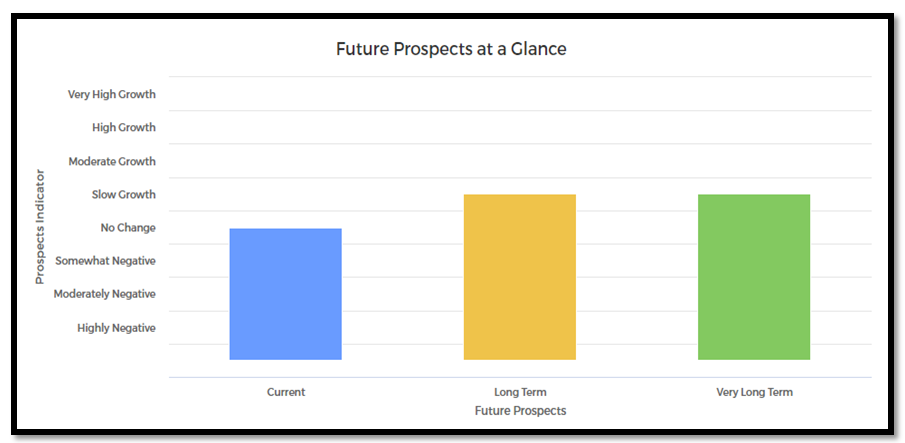
Future Prospects At A Glance
Current (0-1 year) | Long Term (2-5 year) | Very Long Term (6-10 years) |
No Change | Slow Growth | Slow Growth |
